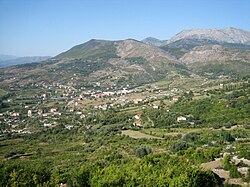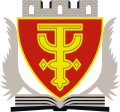Lezhë County
Lezhë County
Qarku i Lezhës (Albanian) | |
|---|---|
 View from Lezhë Castle | |
 | |
| Coordinates: 41°45′N 19°50′E / 41.750°N 19.833°E | |
| Country | |
| Seat | Lezhë |
| Subdivisions | 3 municipalities, 175 towns and villages |
| Government | |
| • Council chairman | Eduart Ndreca (PS) [1] |
| Area | |
• Total | 1,620 km2 (630 sq mi) |
| Population (2023[2]) | |
• Total | 99,384 |
| • Density | 61/km2 (160/sq mi) |
| Time zone | UTC+1 (CET) |
| • Summer (DST) | UTC+2 (CEST) |
| HDI (2022) | 0.764 high · 9th of 12 |
| NUTS Code | AL014 |
| Website | Official Website |
Lezhë County (Albanian: Qarku i Lezhës) is one of the 12 counties of Albania. The population as of 2021 was 120,678,[3] in an area of 1,620 km².[4] Its capital is the city Lezhë.
Administrative divisions
[edit]Until 2000, Lezhë County was subdivided into three districts: Kurbin, Lezhë, and Mirditë. Since the 2015 local government reform, the county consists of the following 3 municipalities: Kurbin, Lezhë and Mirditë.[5] Before 2015, it consisted of the following 21 municipalities:
The municipalities consist of about 175 towns and villages in total. See Villages of Lezhë County for a structured list.
Demographics
[edit]| Year | Pop. | ±% |
|---|---|---|
| 1950 | 45,533 | — |
| 1960 | 63,373 | +39.2% |
| 1979 | 113,621 | +79.3% |
| 1989 | 165,254 | +45.4% |
| 2001 | 159,182 | −3.7% |
| 2011 | 134,027 | −15.8% |
| 2023 | 99,384 | −25.8% |
| Source: [6][7] | ||
As of the 2023 census, this county has 99,384 inhabitants. Ethnic groups in the county as of the 2011 census include:[4]
- Albanians = 116,469 (86.90%)
- Greeks = 41 (0.03%)
- Macedonians = 9 (0.01%)
- Montenegrins = 8 (0.01%)
- Aromanians = 15 (0.01%)
- Romani = 187 (0.14%)
- Egyptians = 240 (0.18%)
- others = 18 (0.01%)
- no answer = 17,040 (12.71%)
- total = 134,027
Demographics
[edit]Between the 2011 and 2023 censuses in Lezhë, the religious landscape showed some shifts. The Muslim population increased its share from 14.8% to 17.5%, and Bektashism also saw a rise from 0.3% to 0.6%. The Catholic Christian population, which remained the dominant group, increased from 72.3% to 74.4%. Orthodox Christians rose from 0.1% to 0.4%. Evangelical Christians increased from 0.0% to 0.2%.
There was a notable increase in the irreligious population: atheists rose from 0.1% to 0.5%, and those identifying as believers without denomination grew from 1.1% to 1.9%. Meanwhile, the "Prefer not to answer" category saw a significant decrease, dropping from 8.0% to 2.6%, and the "Not stated/other" category also decreased from 3.1% to 1.9%.[8]
| Religion group | Census 2011 | Census 2023 | Difference (2023−2011) | |||
|---|---|---|---|---|---|---|
| Number | Percentage | Number | Percentage | Number | Percentage | |
| Muslim | 19,845 | 14.8% | 17,416 | 17.5% | -2,429 | +2.7% |
| Bektashi | 333 | 0.3% | 576 | 0.6% | +243 | +0.3% |
| Total Muslim | 20,178 | 15.1% | 17,992 | 18.1% | -2,186 | +3.0% |
| Catholic Christian | 97,014 | 72.3% | 73,938 | 74.4% | -13,076 | +2.1% |
| Orthodox Christian | 85 | 0.1% | 385 | 0.4% | +300 | +0.3% |
| Evangelical | 17 | 0.0% | 214 | 0.2% | +197 | +0.2% |
| Other Christian | 9 | 0.0% | 33 | 0.0% | +24 | +0.0% |
| Total Christian* | 97,125 | 72.5% | 74,570 | 74.9% | -2,555 | +2.4% |
| Atheists | 175 | 0.1% | 470 | 0.5% | +295 | +0.4% |
| Believers without denomination | 1,459 | 1.1% | 1,856 | 1.9% | +397 | +0.8% |
| Total Non-religious | 1,634 | 1.2% | 2,326 | 2.3% | +692 | +1.1% |
| Prefer not to answer | 10,724 | 8.0% | 2,577 | 2.6% | -8,147 | -5.4% |
| Not stated / Not available** | 4,189 | 3.1% | 1,919 | 1.9% | -2,270 | -1.2% |
| TOTAL | 134,027 | 100% | 99,384 | 100% | -34,643 | – |
References
[edit]- ^ "Konstituohet Këshilli i Qarkut të Lezhës". 6 September 2019.
- ^ "Main Results of the Population and Housing Census 2023" (PDF). INSTAT.
- ^ "Population on 1st January by prefecture and sex" (PDF). INSTAT. 7 May 2021. p. 6.
- ^ a b 2011 census results Archived 2015-09-24 at the Wayback Machine
- ^ "Law nr. 115/2014" (PDF) (in Albanian). pp. 6373–6374. Retrieved 25 February 2022.
- ^ "Division of Albania".
- ^ "Census of Population and Housing". Institute of Statistics Albania.
- ^ "Population statistics of Eastern Europe & former USSR". pop-stat.mashke.org. Retrieved 2025-04-05.


